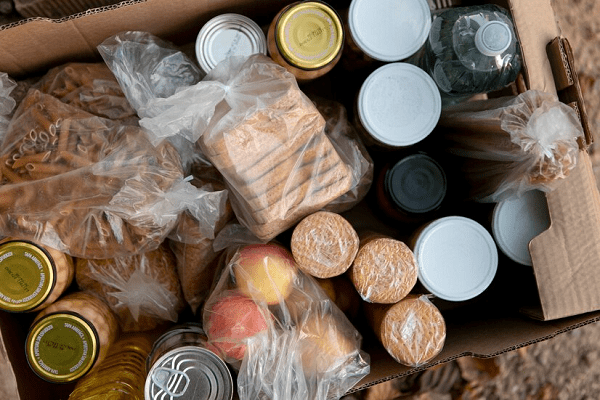Perishables and non‐perishables- “Perishables” and “non-perishables” are terms commonly used in the context of food and goods storage, particularly in the retail and consumer sectors. These terms refer to different types of products based on their shelf life and susceptibility to spoilage:
- Perishables:
- Definition: Perishables are goods or food items that have a relatively short shelf life and are susceptible to spoilage or decay over time.
- Characteristics:
- Perishable foods include fresh fruits, vegetables, dairy products, meats, seafood, and baked goods.
- These items typically have a high water content and can spoil or go bad relatively quickly, often within days or weeks.
- Perishables require specific storage conditions, such as refrigeration or freezing, to extend their shelf life.
- Non-Perishables:
- Definition: Non-perishables are goods or food items that have a long shelf life and are less susceptible to spoilage or decay over time.
- Characteristics:
- Non-perishable foods include canned goods, dried grains, pasta, rice, canned fruits and vegetables, canned soups, and various packaged or processed foods.
- These items have a low water content, are often processed or preserved, and can last for an extended period, sometimes years, without spoiling.
- Non-perishables can be stored at room temperature and do not require special refrigeration or freezing.
The distinction between perishables and non-perishables is important for businesses, consumers, and food safety considerations. Retailers must manage their inventory and storage conditions differently for each category, while consumers need to be mindful of expiration dates and proper storage methods to minimize food waste. Additionally, emergency preparedness often involves stocking up on non-perishable items because they can be stored for extended periods and provide sustenance during emergencies or disasters.
What is Perishables and non‐perishables
Perishables and non-perishables are categories used to classify goods based on their shelf life and ability to spoil or deteriorate over time. These categories are particularly important in the context of food storage and retail, but they can apply to other types of products as well.
- Perishables:
- Definition: Perishables are products that have a limited shelf life and are susceptible to spoilage or decay relatively quickly if not stored properly.
- Characteristics:
- Perishable goods include fresh fruits, vegetables, dairy products, meats, seafood, and baked goods.
- They typically have a high moisture content and are prone to bacterial growth, enzymatic reactions, and other factors that lead to spoilage.
- Perishable items require specific storage conditions, such as refrigeration or freezing, to extend their shelf life and maintain their quality.
- Examples of perishable goods include milk, fresh produce, and fresh meat.
- Non-perishables:
- Definition: Non-perishables are products that have a long shelf life and are less susceptible to spoilage or decay over time.
- Characteristics:
- Non-perishable goods include canned foods, dried grains, pasta, rice, canned fruits and vegetables, packaged snacks, and various processed foods.
- They typically have a low moisture content and are often processed, preserved, or packaged in a way that inhibits spoilage.
- Non-perishables can be stored at room temperature and do not require refrigeration or freezing.
- Examples of non-perishable goods include canned soup, rice, pasta, and canned vegetables.
The classification of goods as perishables or non-perishables is crucial for inventory management, food safety, and consumer purchasing decisions. Businesses must handle these categories differently in terms of storage, distribution, and product rotation to minimize waste and ensure product quality. Consumers need to be aware of these distinctions to make informed choices about how they store and use their purchases, reducing the likelihood of food waste.
Who is Perishables and non‐perishables
In the context of perishables and non-perishables, there isn’t a specific “who” that is required. Instead, the classification of goods into perishables and non-perishables is primarily a matter of categorizing products based on their shelf life and susceptibility to spoilage. This classification is used by businesses, consumers, and regulatory authorities to make informed decisions about handling, storage, and safety related to these products.
So, it’s not about a person or entity being “required,” but rather a classification system used to understand and manage different types of products based on their characteristics and how they should be stored and handled.
“Perishables” and “Non-perishables” are categories or labels applied to products, not names of people or organizations. Perishables refer to goods that can spoil relatively quickly, like fresh fruits or vegetables, while non-perishables refer to goods that have a longer shelf life and are less susceptible to spoilage, such as canned foods or dried grains. These terms are used in various industries, including food retail, to help with inventory management, storage, and distribution.
When is Required Perishables and non‐perishables

The classification of goods into perishables and non-perishables is not dependent on a specific time but rather on the inherent characteristics of the products. Whether a product is considered a perishable or non-perishable is determined by factors such as its shelf life, susceptibility to spoilage, and the conditions required for its preservation.
Here are some general guidelines:
- Perishables:
- These products typically have a short shelf life and can spoil relatively quickly.
- Perishables are often fresh foods like fruits, vegetables, dairy products, meats, and seafood.
- They require specific storage conditions, such as refrigeration, to maintain their freshness and safety.
- Non-perishables:
- Non-perishable products have a longer shelf life and are less susceptible to spoilage.
- They are often processed or packaged in a way that inhibits spoilage, such as canned goods, dried grains, pasta, and packaged snacks.
- Non-perishables can be stored at room temperature for an extended period.
The distinction between perishables and non-perishables is essential for inventory management, food safety, and consumer purchasing decisions. It’s not about a specific time but about recognizing the characteristics of the products and how they should be handled and stored to maintain their quality and safety.
Where is Required Perishables and non‐perishables
The classification of goods into perishables and non-perishables is not location-specific; it applies universally across various regions and countries. These terms are used in the context of inventory management, food storage, and consumer purchasing decisions in many places around the world.
Whether a product is considered a perishable or non-perishable is determined by its inherent characteristics, such as its shelf life and susceptibility to spoilage, rather than where it is located. Perishables, like fresh fruits and vegetables, have a short shelf life and are susceptible to spoilage, while non-perishables, like canned goods and dried grains, have a longer shelf life and are less susceptible to spoilage.
These distinctions are important for businesses, consumers, and regulatory authorities to ensure the safe handling and storage of goods, but they are not tied to a specific geographic location.
How is Required Perishables and non‐perishables
The classification of products as perishables or non-perishables is determined by their inherent characteristics and how they behave over time. Here’s how this classification is determined:
- Shelf Life: The primary factor in classifying goods as perishables or non-perishables is their shelf life, which is the length of time a product can be stored before it becomes unfit for consumption or use.
- Susceptibility to Spoilage: Perishables are products that are highly susceptible to spoilage due to factors such as moisture content, bacterial growth, enzymatic reactions, and other natural processes. Non-perishables, on the other hand, have features or packaging that inhibits spoilage, making them less susceptible to deterioration.
- Storage Conditions: Perishables often require specific storage conditions to extend their shelf life. This may include refrigeration or freezing. Non-perishables can be stored at room temperature without significant quality degradation.
Examples of how goods are classified:
- Perishables: Fresh fruits, vegetables, dairy products, meats, seafood, and baked goods are classified as perishables due to their high moisture content and relatively short shelf life.
- Non-perishables: Canned goods, dried grains, pasta, rice, packaged snacks, and processed foods are considered non-perishables because they have a low moisture content and are processed or packaged to resist spoilage.
It’s important to note that the classification of goods into perishables and non-perishables is not subjective but is based on scientific and practical factors related to the products’ behavior over time. These distinctions help businesses, consumers, and regulators make informed decisions regarding handling, storage, and safety.
Case Study on Perishables and non‐perishables
Smith’s Supermarket
Background: Smith’s Supermarket is a medium-sized grocery store chain located in a suburban area. They sell a wide range of products, including perishables and non-perishables, to meet the needs of their customers.
Challenges: Smith’s Supermarket faces several challenges in managing perishable and non-perishable goods efficiently:
- Inventory Management: They need to ensure that perishable items such as fresh produce, dairy, and meats are sold before their expiration dates, while minimizing waste. Simultaneously, they must maintain an adequate stock of non-perishable items to meet customer demand.
- Storage: Perishables require cold storage, while non-perishables need regular shelving space. Efficient storage and rotation of products are essential to maintain product quality and minimize losses.
- Seasonal Variations: Certain perishables, like seasonal fruits and vegetables, have fluctuating demand. Smith’s needs to adjust their inventory accordingly to avoid overstocking or understocking.
Strategies: Smith’s Supermarket employs several strategies to address these challenges:
- Inventory Tracking: They use a computerized inventory management system to track the shelf life of perishables. This system generates alerts when products are nearing their expiration dates, enabling timely markdowns or promotions to reduce waste.
- Just-In-Time Ordering: For perishables, they implement just-in-time ordering practices to minimize excess inventory. They establish close relationships with local suppliers to receive fresh produce and dairy products regularly.
- Seasonal Promotions: During peak seasons for certain perishable items (e.g., summer for watermelons), Smith’s Supermarket runs promotions to encourage sales and reduce overstock.
- Storage and Display: Perishable items are stored in refrigerated units with first-in, first-out (FIFO) rotation to ensure that older products are sold before newer ones. Non-perishables are organized efficiently on regular store shelves.
- Customer Education: The supermarket provides information to customers on the shelf life and proper storage of perishables to help reduce food waste at the consumer level.
Outcomes: By implementing these strategies, Smith’s Supermarket has been successful in managing perishable and non-perishable goods effectively:
- Reduced food waste and spoilage of perishable items.
- Maintained product quality and freshness, resulting in satisfied customers.
- Optimized inventory levels to minimize storage costs while meeting customer demand.
- Increased sales through strategic promotions during seasonal peaks.
- Enhanced customer loyalty through education on food storage and waste reduction.
In conclusion, the case study of Smith’s Supermarket demonstrates the importance of effective management and differentiation between perishable and non-perishable goods in the retail industry. Implementing smart inventory practices and understanding customer needs and seasonal variations are key to success in this context.
White paper on Perishables and non‐perishables
Title: Understanding Perishables and Non-perishables: Strategies for Efficient Inventory Management and Sustainability
Abstract: A brief summary of the white paper’s key points and findings.
Table of Contents:
- Introduction
- Definition and importance of perishables and non-perishables
- Purpose and scope of the white paper
- Overview of key topics
- Perishables vs. Non-perishables: Key Characteristics
- Definition and characteristics of perishables
- Definition and characteristics of non-perishables
- Examples of products in each category
- Challenges in Managing Perishables
- Shelf life considerations
- Susceptibility to spoilage and waste
- Storage and handling requirements
- Seasonal variations
- Efficient Inventory Management for Perishables
- Inventory tracking and management systems
- Just-in-time ordering practices
- Effective storage and rotation strategies
- Reducing food waste through inventory management
- Strategies for Non-perishables
- Inventory optimization
- Stocking and shelving practices
- Seasonal promotions and demand forecasting
- Sustainability considerations
- Case Studies
- Real-world examples of businesses successfully managing perishables and non-perishables
- Lessons learned and best practices
- Sustainability and Environmental Impact
- The environmental footprint of perishables and non-perishables
- Strategies for reducing waste and promoting sustainability
- The role of consumers in sustainable consumption
- Future Trends and Innovations
- Emerging technologies in inventory management
- Sustainable packaging and product design
- Consumer trends shaping the industry
- Conclusion
- Recap of key takeaways
- Importance of effective management of perishables and non-perishables
- Call to action for businesses and consumers
- References
- Citations and sources for the information presented in the white paper
Appendix: Additional resources, charts, and graphs related to perishables and non-perishables.
This outline can serve as a framework for your white paper, and you can expand on each section with detailed research, case studies, and practical insights to create a comprehensive and informative document on the topic of perishables and non-perishables.





